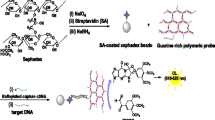Abstract
Two kinds of streptavidin magnetic particles, namely streptavidin GoldMag particles and streptavidin amino terminal particles were prepared by the methods of physical adsorption and covalent interaction respectively. The streptavidin coated on magnetic particle surface, crucial to many applications, was greatly influenced by the choice of the different buffer. Compared with Dynalbeads®M-270 streptavidin, the binding capacity for biotin of different streptavidin magnetic particles was determined by enzyme inhibition method, and the coupling capacity and activity of biotinylated oligonucleotide on their surface were also analyzed. The results indicated that the streptavidin GoldMag particle prepared by physical adsorption was stable in STE (NaCl-Tris-EDTA) buffer that was frequently used in nucleic acid hybridization and detection. The streptavidin amino terminal particles prepared by covalent interaction could be used both in STE buffer and PBS (phosphate buffered saline) buffer. The biotin binding capacity for 1 mg of streptavidin GoldMag particles and streptavidin amino terminal particles was 4950 and 5115 pmol respectively. The capacity of biotinylated oligonucleotide (24 bp) coupled on 1 mg of GoldMag and amino terminal magnetic particles was 2839 and 2978 pmol separately. These data were about 6–7 times higher than those of Dynabeads®M-270 streptavidin. The hybridization results with FITC-labeled complementary probe on magnetic particle surface demonstrated that the oligonucleotide coupled on streptavidin magnetic particles had high biological activity.
Similar content being viewed by others
References
Bayer E A, Ben-Hur H, Wickchek M. Isolation and properties of streptavidin. Methods Enzymol, 1990, 184: 80–89
Green N M. Avidin and streptavidin. Methods Enzymol, 1990, 184: 51–67
Shen G X, Zhou R L. Experimental Technology of Modern Immunology (in Chinese). 2nd ed. Wuhan: Hubei Science & Technology Press, 2002. 220–221
Huhtinen P, Soukka T, Lovgren T, et al. Immunoassay of total prostate-specific antigen using europium(III) nanoparticle labels and streptavidin-biotin technology. J Immunol Methods, 2004, 294: 111–122
Xie X, Zhang X, Gao H F, et al. DNA purification and gene typing: Based on multifunctional nanobeads. Chin Sci Bull, 2004, 49(9): 886–889
Garcia-Martinez L F, Bilter G K, Wu Jun, et al. In vitro high-throughput screening assay for modulators of transcription. Anal Biochem, 2002, 301(1): 103–110
Sun Y R, Wang Y Q. Biotin-avidin system and its application. High Tech Lett (in Chinese), 2000, 10(3): 95–97
Valimaa L, Pettersson K, Rosenberg J, et al. Quantification of streptavidin adsorption in microtitration wells. Anal Biochem, 2004, 331: 376–384
Butler J E, Ni L, Nessler R, et al. The physical and functional behavior of capture antibodies adsorbed on polystyrene. J Immunol Methods, 1992, 150: 77–90
Davies J, Dawkes A C, Haymes A G, et al. A scanning tunneling microscopy comparison of passive antibody adsorption and biotinylated antibody linkage to streptavidin on microtiter wells. J Immunol Methods, 1994, 167: 263–269
Butler J E. Solid supports in enzyme-linked immunosorbent assay and other solid-phase immunoassays. Methods, 2000, 22: 4–23
Cui Y L, Chen C, Hui W L, et al. A composite magnetic particle with assembled structure, preparation method and use thereof. China Patent, CN 1580765, 2005
Cui Y L, Hui W L, Su J, et al. Fe3O4/Au composite nano-particles and their optical properties. Sci China Ser B-Chem, 2005, 48(4): 273–278
Cui Y L, Hui W L, Wang H R, et al. Preparation and characterization of Fe3O4/Au composite particles. Sci China Ser B-Chem, 2004, 47(2): 152–158
Cui Y L, Hu D D, Fang Y, et al. Preparation and mechanism of Fe3O4/Au core/shell super-paramagnetic microspheres. Sci China Ser B-Chem, 2001, 44(4): 404–410
Cui Y L, Wang Y N, Hui W L, et al. The synthesis of GoldMag nano-particles and its application for antibody immobilization. Biomed Microdev, 2005, 7(2): 153–156
Yan X Y, Liu D, Cui Y L. Synthesis and characterization of functional Fe3O4 magnetic particles. J Shaanxi Norm Univ (in Chinese), 2005, 33(2): 69–73
Dorgan L, Magnotti R, Hou J, et al. Methods to determine biotin binding capacity of streptavidin-coated magnetic particles. J Magn Magn Mater, 1999, 194: 69–75
Gan Z B, Marquardt R R. Colorimetric competitive inhibition method for the quantitation of avidin, streptavidin and biotin. J Biochem Bioph Meth, 1999, 39: 1–6
Kada G, Falk H, Gruber H J. Accurate measurement of avidin and streptavidin in crude bio£uids with a new, optimized biotinfluorescein conjugate. Biochimica Biophysica Acta, 1999, 1427: 33–43
Charles P T, Vora G J, Andreadis J D, et al. Fabrication and surface characterization of DNA microarrays using amine-and thiol-terminated oligonucleotide probes. Langmuir, 2003, 19(5): 1586–1591
Deng C H, Shen M H, Zhao C X. Covalent immobilization of oligonucleotides onto solid substrates in the manufacturing of DNA chips. Chin J Org Chem (in Chinese), 2002, 22(12): 943–950
Hofstetter H, Morpurgo M, Hofstetter O. A labelling, detection, and purification system based on 4-hydroxyazobenzene-2-carboxylic acid: An extension of the avidin biotin system. Anal Biochem, 2000, 284: 354–366
Savage D, Mattson G, Desai S, et al. Avidin-Biotin Chemistry: A Handbook. Rockford: Pierce Chemical Co., 1992
Dynalbeads ®M-270 Streptavidin Instruction, Dynal Biotech ASA, Oslo. Norway, 2004 (Produce#353.02)
Author information
Authors and Affiliations
Corresponding authors
Additional information
Supported by the National Natural Science Foundation of China (Grant No. 20273050) and the National High Technology Research and Development Program of China (Grant No. 2005AA205220)
Rights and permissions
About this article
Cite this article
Zhang, Z., Zhu, H., Tang, Y. et al. Preparation and application of streptavidin magnetic particles. SCI CHINA SER B 50, 127–134 (2007). https://doi.org/10.1007/s11426-007-2031-3
Received:
Accepted:
Issue Date:
DOI: https://doi.org/10.1007/s11426-007-2031-3




